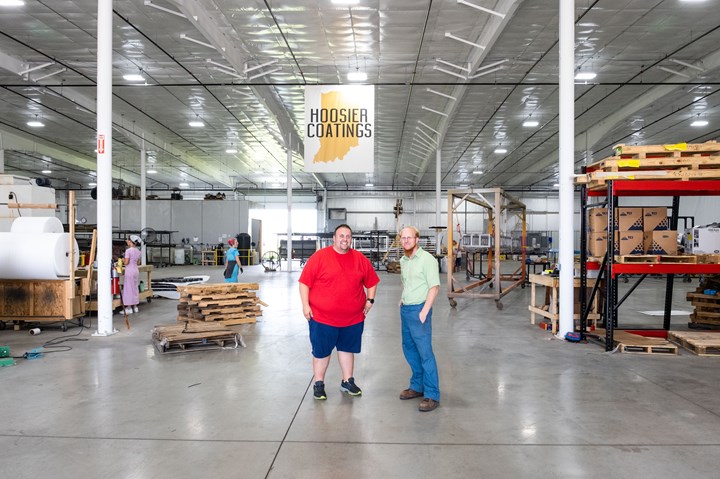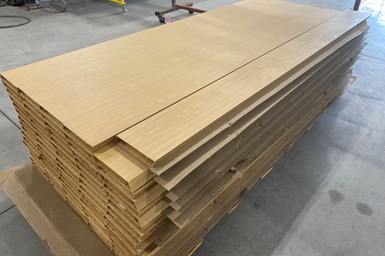
Jimmy Faroh and Nelson Miller, co-founders of Nappanee, Indiana-based Hoosier Coatings, have been working together for a long time. Their business relationship began at a company that finishes doors and other parts for RVs, where they developed expertise in finishing large, unwieldy parts. This led Faroh and Miller — the shop’s production superintendent and quality manager, respectively — to recognize a significant need in the area for larger, longer parts.
Faroh says, “The RV company needed longer extrusions and larger powder-coated items, and a lot of powder coaters in the area are on automated systems and can’t run longer items. We asked around and quite a few people had the same issue.” This realization led Faroh and Miller to open Hoosier Coatings together in 2016, and now they serve a growing number of industries, including agricultural, general industrial and architectural — all of which require significantly sized parts that can hold up to tough applications.
Featured Content
Turning humble beginnings into escalating opportunities
Hoosier Coatings began in an 8,000-square-foot shop area on Miller’s property where, over the next five years, Faroh and Miller began to grow their business with a powder coating and sandblasting system. “We were basically doing a lot of individual jobs like car parts, car rims and patio furniture,” Faroh says. The pair began to grow a reputation in the local community, and the one-off odd jobs began to turn into extended contracts with increasingly large companies.
In November 2021, Hoosier moved off Miller’s property into its own dedicated facility, which now boasts a 40,000-square-foot shop floor. While this may be a big jump in size for the company, it took the partners less than a year to fill it with new booths, systems and capabilities to better serve their existing customers, as well as to take on new work.
Hoosier Coatings’ move into a larger facility has enabled the shop to fine tune its processes for existing customers, as well as take on new work.
With its new, fully equipped facility, the shop has cut lead times significantly. At the old facility, “we were consistently six, seven, eight weeks out on lead time,” Faroh says. “The primary goal when moved here was to get the lead time down for our existing customers. Because we see that as a partnership, we need to do our part to get them what they need quicker.”
The new facility has not only reduced Hoosier’s lead times to just a week or two depending on the job, but it has also enabled the shop to expand from one batch oven to four, as well as add a brand new sandblasting system for stainless-steel parts. But the real wildcard for Hoosier will be its new Decoral sublimation coating system, a unique capability that only a handful of shops in the U.S. specialize in, including Hoosier.
“Decoral is a process out of Italy and it’s popular in Europe, but it’s not that popular in the United States yet. It allows us to sublimate or decorate extrusions up to 24-feet long, as well as sheet metal,” Faroh says. “The process begins by powder coating [the part] with an architectural-grade coating first, and then putting a film wrap around it, which carries the ink that then sublimates into the powder. You’re getting all of the excellent properties of a powder coat — the extra exterior durability, the UV stability — but you also don’t have to worry about it delaminating or peeling.”
The Decoral process starts with an industrial-grade powder coat, and then a film is wrapped around the part which then sublimates the coating with a decorative pattern.
Hoosier primarily uses the Decoral system to finish large exterior parts with wood-grain or marbled finishes. Decoral finishes can be found in decorative awnings, handrails, exterior rails for porches and decks and also building surface panels. Faroh expects the market to be a significant growth point for the shop in the coming years, saying, “As involved as we are in architectural, that’s definitely going to be a very big focus for us. Having a place to do that process was a driving force for us to move into the new building.”
Preparing for further growth
According to Faroh, Hoosier has experienced about 30% growth year-over-year since opening, which he says has totally exceeded his expectation from the start. The company has no plans of slowing down; rather, Faroh hints that Hoosier is already eyeing another expansion to their facility, as well as a new product line. He says, “In the next five years, we’re planning to expand the shop again. We have our eye on a 20,000-square-foot expansion. And we’re also working with the Decoral system to expand our product line into aluminum cabinetry.”
Now, with its 20 employees and fully furnished facility, Hoosier is capable of following where its customers go. Every business decision Hoosier’s leadership makes is informed by what needs they see in the market and what their customers are asking for, which is a strategy they’ve used since the very beginning. Faroh says, “When we know what our customers’ picture is going forward, then we can adapt to it, plan on it and grow with it.”
RELATED CONTENT
-
Rework and Recoating Powder
Powder coating rework requires more than just recoating the part. Products Finishing columnist and powder coating consultant Rodger Talbert discusses proper steps that should be taken to ensure a quality finish.
-
Powder Coating Aluminium Adhesion Failure
PF columnist Rodger Talbert offers advice for mitigating adhesion failure of powder coating on aluminum parts.
-
Powder Coatings vs Energy-Cure Coatings
Examining the basic differences between powder coatings and energy-cure coatings can help answer the question of whether or not one of these technologies might be appropriate for a specific application.























